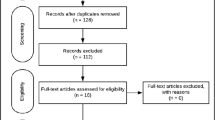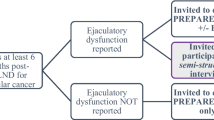Abstract
This is a qualitative study where young men who underwent treatment for nonseminomatous testicular cancer told of their experiences. Using an ethnographic method, three themes emerged from the data: 1) feelings of shock, disbelief, and despair, 2) physical and emotional trauma, and 3) a renewed appreciation of life. These themes often occurred within stages of treatment. Stage 1) symptoms, first surgery (orchiectomy, which includes biopsy), diagnosis, and recovery period; Stage 2) second surgery (lymphadenectomy); diagnostic tests for metastases, and recovery period; Stage 3) chemotherapy regimens; and Stage 4) 3-year disease free period following treatment. This research adds to the dearth of information available on how young males experience treatment for a potentially lethal disease.
Similar content being viewed by others
REFERENCES
Agar, M. H. (1980). The professional stranger. Orlando, Academic Press, Inc.
American Cancer Society. (1990). Cancer facts & figures-1990. Atlanta:Author.
Berscheid, E., Walster, E. & Bohrnstedt, G. (1973). Body image: the happy american body: a survey report. Psychology Today, Nov. 119–131.
Berthelson, J. G. (1987). Testicular cancer and fertility. International Journal of Andrology, 10, 371–380.
Bogdan, R. C. & Biklen, S. K. (1982). Qualitative research for education: An introduction to theory and methods. Boston: Allyn & Bacon.
Bosl, G.J., Vogelzang, N. J., Goldman, A., Fraley, E. E., Lange, P. H., Levitt, S. H., Kennedy, B. J. (1981). Impact of delay in diagnosis on clinical stage of testicular cancer. Lancet, 8253: 970–972.
Bracken, R. B., Johnson, D. E., (1976). Sexual function and fecundity after treatment for testicular tumors. Urology, 7: 35–38.
Brenner, J., Vugrin, D., Whitmore, W. F. (1985). Effect of treatment on fertility and sexual function in males with metastatic nonseminomatous germ cell tumors of testis. American Journal of Clinical Oncology, 8: 178–182.
Brodsky, M. S. (1995). Testicular Cancer Survivors' Impressions of the Impact of the Disease on Their Lives. Qualitative Health Research, 5,1, 78–96.
Calderwood, D. (1984). Gender, gender role, and sexual health. SIECUS Report, 13,2, 1, 3–5.
Carbonell, M. A., Taseff, L., Sciarra, L., Isaac, E., (1986). Managing the Patient with Testicular Cancer. Nursing 86, August, 42–45.
Cash, T. F., Winstead, B. A., & Janda, L. H. (1986). The great american shape-up. Psychology Today, 20, 30–37.
Cassileth, B. R., & Steinfeld, A. D., (1987). Psychological preparation of the patient and family. Cancer, 60, 547–552.
Dierkhising, J. T., (1987). Formulating an educational model: consideration of the impact of cancer on self-image and sexuality. Journal of Psychosocial Oncology, 5,1, 89–102.
Donohue, J. P., Einhorn, L. H., & Perez, J. M. (1978). Improved management of nonseminomatous testis tumors. Cancer 42,6, 2903–2908.
Einhorn, L. H., (1987). Chemotherapy of disseminated germ cell tumors. Cancer, 60,3, 570–573.
Farrell, W., (1974). The Liberated Man. New York: Random House.
Fiore, N. (1979). Fighting cancer—One patient's perspective. The New England Journal of Medicine, 300,6, 284–289.
Fraley, E. E., Lange, P. H., & Kennedy, B. J. (1979). Germ-cell testicular cancer in adults. (First of Two Parts) The New England Journal Of Medicine, 301,25, 1370–1377.
Fraley, E. E., Lange, P. H., & Kennedy, B. J. (1979). Germ-cell testicular cancer in adults. (Second of Two Parts) The New England Journal Of Medicine, 301,26, 1420–1426.
Friman, P. C., Finney, J. W., Glasscock, S. G., Weigel, J. W., and Christopherson, E. R., (1986), Testicular self-examination: validation of a training strategy for early cancer detection. Journal of Applied Behavior Analysis, 19,1, 87–92.
Ganong, L. H., & Markovitz, J. (1987). Young men's knowledge of testicular cancer and behavioral intentions toward testicular self-exam. Patient Education and Counseling, 9,3, 251–261.
Gault, P. L. (1981). Taking your part in the fight against testicular cancer. Nursing 81, May, 47–50.
Golden, J. S. & Golden, M. (1980). Cancer and Sex. In J. M. Vaeth, R. C. Blomberg, & L. Adler (Eds.) Body image, self-esteem and sexuality in cancer patients. Frontiers of Radiation Therapy and Oncology, Vol. 14, 59–65.
Gorzynski, G. J. & Holland, J. C. (1979). Psychological aspects of testicular cancer. Seminars in Oncology, 6,1, 125–129.
Graham, S. & Gibson, R. W. (1972). Social epidemiology of cancer of the testis. Cancer 29, 1242–1249.
Henderson, D., (1989). Early detection the key to success against testicular cancer. FDA Consumer, Dec–Jan, 16–19.
Jaffe, D. T. (1985). Self-renewal: personal transformation following extreme trauma. Journal of Humanistic Psychology, 25,4, 99–124.
Kedia, K. R., Marland, C., & Fraley, E. E., (1977). Sexual function after high retroperitoneal lymphadenectomy. Urology Clinic North America, 4: 523–528.
Kennedy, B.J., Tellegen, A., Kennedy, S., & Havernick, N. (1976). Psychological response of patients cured of advanced cancer. Cancer, 38, 2184–2191.
Li, F. P., Connely, M., & Myers, M., (1982). Improved survival rates among testis cancer patients in the United States. Journal of the American Medical Association, 247,6, 825–826.
Lincoln, Y. S., & Guba, E. G. (1985). Naturalistic inquiry. Beverly Hills, CA: Sage.
Lipsyte, R. (1993). Magic markers. American Health, September, 25–26.
Liss-Levinson, W. S. (1982). Clinical observations on the emotional responses of males to cancer. Psychotherapy: Theory, Research and Practice, 19,3, 325–330.
Marty, P. J. & McDermott, R. J., (1983) Teaching about testicular cancer and testicular self-examination. Journal of School Health, 53,6, 351–356.
McClure, R. D. (1988). Men with one testicle. Medical Aspects of Human Sexuality, 22,5, 22–32.
Miles, M. B. & Huberman, A. M. (1984). Qualitative data analysis: A sourcebook of new methods. Beverly Hills, CA: Sage Publications.
Moreland, C. (1982). Disabilities and how to live with them: Teratoma of the testis. Lancet, 2, 203–205.
National Cancer Institute. (1986). Testicular cancer: Research report (NIH Publication No. 87–654). Washington, DC: U.S. Government Printing Office.
Narayan, P., Lange, P. H. & Fraley, E. E., (1982). Ejaculation and fertility after extended retroperitoneal lymph node dissection for testicular cancer. The Journal of Urology, 127, 685–688.
Patton, M. Q. (1990). Qualitative Evaluation and Research Methods, 2nd Ed. Newbury Park, CA: Sage.
Prout, G. R. & Griffin, P. P. (1984). Testicular tumors: delay in diagnosis and influence on survival. American Family Physician, 29,5, 205–209.
Raloff, J. (1994). Manhood's Cancer. Science News, 145, 138–140.
Riessman, C. K. (1987). When gender is not enough: Women interviewing women. Gender and Society, 1, 172–207.
Rogers, C. R. (1951). Client-centered therapy, its current practice, implications, and theory. Boston, Houghton Mifflin. Social Science and Medicine, 15E, 275–265.
Schottenfeld, D., Warshauer, M. E., Sherlock, S., Zauber, A. E., Leder, M., & Payne, R. (1980). The epidemiology of testicular cancer in young adults. American Journal of Epidemiology, 112, 232–247.
Schover, L. R. (1987). Sexuality and fertility in urologic cancer patients. Cancer, 60, 553–558.
Schover, L. R. and von Eschenbach, A. C. (1985). Sexual and marital relationships after treatment for nonseminomatous testicular cancer. Urology, 25,3, 251–255.
Schover, L. R. and von Eschenbach, A. C. (1984). Sexual and marital counseling with men treated for testicular cancer. Journal of Sex & Marital Therapy, 10,1, 29–40.
Secord, P. F., & Jourard, S. L. (1953). The appraisal of body cathexis: body cathexis and the self. Journal of Consulting Psychology, 17, 343–347.
Sheehy, G. (1974). Passages: Predictable crises of adult life. New York: Bantam Books.
Small, M. P. (1984). Testicular prosthesis. Medical Aspects of Human Sexuality, 18,10, 127–132.
Spitz, M. R., Sider, J. G., Pollack, E. S., Lynch, K. H., and Newell, G. R. (1986). Incidence and descriptive features of testicular cancer among United States whites, blacks, and hispanics, 1973–1982. Cancer, 58,8, 1785–1790.
Spradley, J. P. (1979). The ethnographic interview. New York: Holt, Rinehart & Winston.
Taylor, S. J. & Bogdan, R. (1984). Introduction to qualitative research methods: The search for meanings. New York: John Wiley & Sons.
van Manen, M. (1990). Researching lived experience. Human science for an action sensitive pedagogy. London, Ontario: Althouse Press.
von Eschenbach, A. C. (1980). Sexual dysfunction following therapy for cancer of the prostate, testis, and penis. In J.M. Vaeth (Ed.), Frontiers of radiation therapy and oncology (pp. 42–48). California. Darger, Basel.
Walker, R. (1993). Modeling and Guided Practice as Components Within a Comprehensive Testicular Self-Examination Educational Program for High School Males. Journal of Health Education, 24,3, 162–168.
Walker, R. & Guyton, R., (1989). Modeling and guided practice as components within a comprehensive testicular self-examination cancer education program. Journal of American College Health, 37,3, 211–215.
Wood, J. D., & Tombrink, J. (1983). Impact of cancer on sexuality and self-image: a group program for patients and partners. Social Work in Health Care, 8,4, 45–54.
Author information
Authors and Affiliations
Rights and permissions
About this article
Cite this article
Brodsky, M.S. The Young Male Experience with Treatment for Nonseminomatous Testicular Cancer. Sexuality and Disability 17, 65–77 (1999). https://doi.org/10.1023/A:1021455813897
Issue Date:
DOI: https://doi.org/10.1023/A:1021455813897




